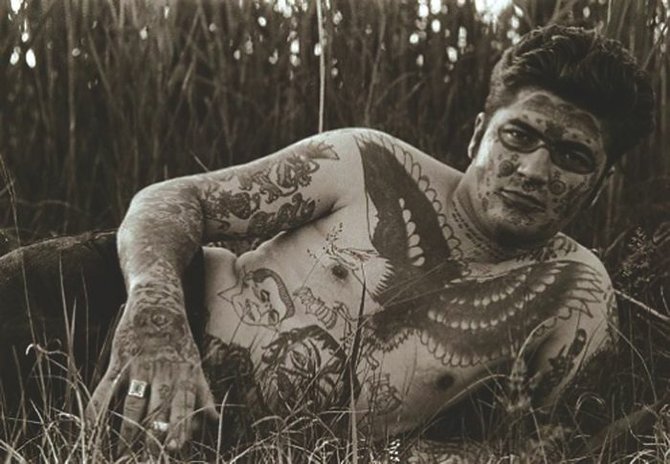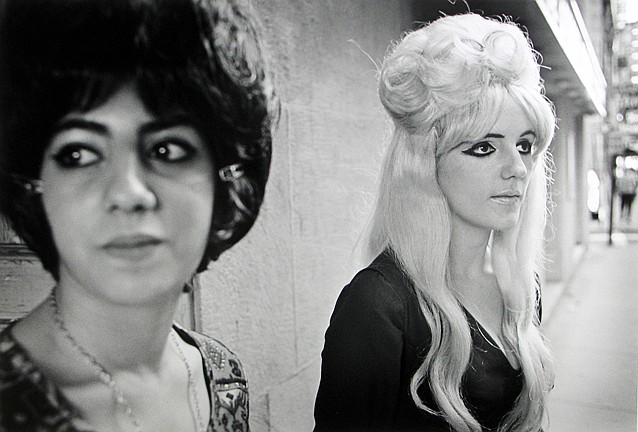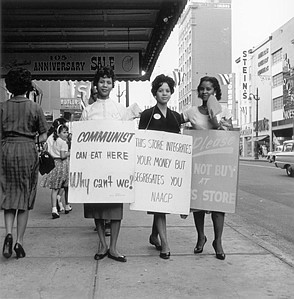 Facebook
Facebook
 X
X
 Instagram
Instagram
 TikTok
TikTok
 Youtube
Youtube

The atrium at the Museum of Photographic Arts offers an essay on what we thought we were as a people during the ’50s and ’60s. Constellated images by several photographers tell us that, before anything else, our wheels defined us. Witness Robert Frank’s 1956 picture of an Indianapolis couple in studded denim jackets enthroned on a Harley. Frank’s The Americans, the 1959 book where the picture first appeared, was foundational to virtually all street photography made over the next 20 years. A generation later, Danny Lyon’s snapshot of a Chicago biker gang trails them down an empty highway expanse, an image that could have illustrated lines from Thom Gunn’s poem “On the Move”:
“A minute holds them, who have come to go:/ The self-defined, astride the created will/ They burst away.”
The poem is from 1957, Lyon’s photo from 1966, three years before Steppenwolf’s “Born to Be Wild” hymned and howled open-road freedom in Easy Rider.
The photos also testify. We’re a bluntly religious people who love to shout out our spirituality. (And not just in the heartland and the South: walk past Baptist churches any Sunday in Harlem or the Mission District or North Philadelphia.) Witness Lee Friedlander’s self-portrait in a car (more wheels) by a roadside shrine and its sign: GOD BLESS AMERICA. Cousin to religious fervor is faith in causes like civil rights. See the covered wagon in Ernest Withers’s Mule Train Leaves for Washington, Poor People’s March, Marks, MS, 1968, or Bruce Davidson’s picture of a black youth in white face, the word VOTE marked on his forehead. We’re obsessed with both authenticity and medicine shows, with Frederick Wiseman–style documentaries and reality TV, so look also at Jerry Berndt’s picture of two Boston hookers, one dark-eyed and fleshy, the other Barbie perfect. You’re forgiven if at first look you wonder which one’s real.

The images are the threshold to the Museum of Photographic Arts’ Streetwise: Masters of ’60s Photography, an intense revisiting of what happened when straight-up, rough-and-tumble street photography — which refused to prettify or ignore physical reality’s brute immediacy — confronted the social and psychic turbulence of the time, in particular the civil rights movement. Black-and-white street photography starkly isolates the actual in an instant of time. It’s magisterially selective and tells us what, for the moment, suffices, that this or this is what we most need to know. Even very little visual information can be enormously enough, as in Frank’s famous image of a glinting two-lane blacktop extending to the infinitude of the horizon. He was, like the other artists in this punchy exhibition — Friedlander, Lyon, Berndt, Davidson, Withers, Diane Arbus, and Ruth-Marion Baruch — a poet of American extremities. “Black and white,” he said, “are the colors of photography. To me they symbolize alternatives of Hope and Despair.” The Hope is illustrated by Baruch’s adulatory portraits of Eldridge Cleaver, Bobby Seale, and other Black Panthers in 1960s Oakland; the Despair by Lyon’s biblical images of young black men on a prison farm hoeing or picking cotton.
These artists were seekers of the ignored, the passed-over and oppressed, the America that lived unseen in plain sight. One Frank photo isolates in sharp focus an elevator girl while the dressed-for-success riders she serves are blurred. When African-Americans renounced invisibility and organized mass protests, rode segregated buses, and integrated all-white schools, artists such as Lyon and Davidson were there to visually supercharge the change. In Davidson’s picture of a queenly young black woman at a lunch counter elbow to elbow with a white woman in taffeta, pearls, and white gloves, the first looks straight at the camera, the other down into her paper cup with petulant disgust (for her drink? the photographer? her counter-mate?).
Sue me if I’m too enthusiastic, but I have strong feelings about this period in American photography and its austere, stop-on-a-dime style because I lived through it, first in Philadelphia, then in San Francisco — the social dissonance, existential self-determination, revolutionary fervor, delusional ideology, failed aspirations, illusions, and hypocrisies. Memory Lane can be a slippery place. In the Bay Area, say “Huey” and everyone knew you meant Huey Newton, celebrity leader of the Panthers, an organization that provided food for poor children, policed the police, insisted on dignities too long denied, and (bearing arms publicly) announced their resolve to improve the lives of African-Americans by whatever means necessary. Baruch’s images get all that. The Panthers were also divisive; their arrogance could turn to cruelty. Huey was a thief, woman-beater, and presumed murderer. Eldridge Cleaver, in his best-seller Soul on Ice, said that raping white women was “an insurrectionary act.” It could be a madly disorienting time: the hope of radical, meliorative social change got mongreled, in typical American style, with the heady misrule of rock, hallucinogens, zoom-zoom sex, and the Zodiac murders.
Jerry Berndt was a night-crawler, but his nocturnes don’t console or lull. His blacker-than-black blacks look like pelt; he makes whatever light falls upon seem a guilty thing exposed, that thing being the raw commerce of sexual allure and appetite. His pictures here come from a series on Boston’s “Combat Zone,” where you could find whatever sexual indulgences you drooled for. A young (he looks about 12) pimp and wannabe gangster, dressed in hip finery with poncy satin ruff and cuffs, dares you to mock his line of work. You look in vain for the child he very recently was. The hooker in another Berndt picture could be an old-style glamour queen leaving a Harlem club. No sleaze clings to her. Hers, in fact, is the most gorgeous face in the exhibition. The nastiest, in another Berndt picture, belongs to a guy carrying a sign declaring JESUS IS COMING AGAIN, as if He’s visited many times before without much success.
Some images are so embedded in our national imaginative archive that you wouldn’t believe they could be seen afresh, and yet a Lee Friedlander picture I’ve seen dozens of times woke me from familiarity’s sleepiness: the woman’s face that fills a motel room’s oval TV screen looks trapped, more happily and grotesquely than ever, inside a spaceman’s helmet. Friedlander loves reality’s crispness, and he teases our desire to isolate one piece of visual information from another. People in his pictures constantly move in cross directions, with contrary signage arrows adding to the busyness. He’d agree with Gary Winogrand’s remark that “the true business of photography is to capture a bit of reality on film.” But what’s reality? For street photographers it’s local, close-up, physical reality, streaked with ambiguous moral content. Early in the last century, William Carlos Williams wrote poems about the anarchy that lived like a latent gene in our political and cultural institutions. Winogrand didn’t only find normalcy in the bizarre (see the well-dressed, mixed-race couple visiting the Central Park Zoo, each carrying a chimp), he also caught the scent of America’s ideological frenzies. His pictures of thorny thickets of American flags at political rallies have a scary fascistic energy.
The oddest duck in this exhibition is Diane Arbus, whose images occupy that one-of-a-kind space I think of as “Diane’s Photo Booth,” the sealed chamber of her scrutiny — asphyxiating, darksome, inquisitorial. She wasn’t by any stretch a street photographer, and she wasn’t much concerned with public issues, but she said something that speaks for the desire of all these photographers to uncover the revelatory: “I really believe there are things nobody would see if I didn’t photograph them.” The human beings in her squirmy images puzzle over us as much as we puzzle over them. Her picture of a woman with a crawly mole on her face reveals an incipient terror so many of us carry unacknowledged. And her overall-tattooed Marked Man and dyspeptic Mad Man from Massachusetts and back-alley Uncle Sam all behold and evaluate us while we return the favor.

Straight photography vacuums up appearances. It swears to what’s apparent. Arbus liked to remind us that there are secrets everywhere, especially when we think we’re seeing something exposed. The heroic photos Ernest Withers made of black sanitation strikers in Memphis, of a woman brandishing her newly acquired voting card, and of Dr. King being stopped by police at Medgar Evers’s funeral — these carry somber moral authority. They’re the most politically eloquent images in the show, and yet, appearances being what they are, it was learned much later that from 1968 to 1971 Withers worked as an FBI informant, snitching for J. Edgar Hoover on civil rights leaders, including Dr. King. ■
Streetwise: Masters of ’60s Photography is on view at the Museum of Photographic Arts until May 15. 1649 El Prado, 619-238-7559, mopa.org.


The atrium at the Museum of Photographic Arts offers an essay on what we thought we were as a people during the ’50s and ’60s. Constellated images by several photographers tell us that, before anything else, our wheels defined us. Witness Robert Frank’s 1956 picture of an Indianapolis couple in studded denim jackets enthroned on a Harley. Frank’s The Americans, the 1959 book where the picture first appeared, was foundational to virtually all street photography made over the next 20 years. A generation later, Danny Lyon’s snapshot of a Chicago biker gang trails them down an empty highway expanse, an image that could have illustrated lines from Thom Gunn’s poem “On the Move”:
“A minute holds them, who have come to go:/ The self-defined, astride the created will/ They burst away.”
The poem is from 1957, Lyon’s photo from 1966, three years before Steppenwolf’s “Born to Be Wild” hymned and howled open-road freedom in Easy Rider.
The photos also testify. We’re a bluntly religious people who love to shout out our spirituality. (And not just in the heartland and the South: walk past Baptist churches any Sunday in Harlem or the Mission District or North Philadelphia.) Witness Lee Friedlander’s self-portrait in a car (more wheels) by a roadside shrine and its sign: GOD BLESS AMERICA. Cousin to religious fervor is faith in causes like civil rights. See the covered wagon in Ernest Withers’s Mule Train Leaves for Washington, Poor People’s March, Marks, MS, 1968, or Bruce Davidson’s picture of a black youth in white face, the word VOTE marked on his forehead. We’re obsessed with both authenticity and medicine shows, with Frederick Wiseman–style documentaries and reality TV, so look also at Jerry Berndt’s picture of two Boston hookers, one dark-eyed and fleshy, the other Barbie perfect. You’re forgiven if at first look you wonder which one’s real.

The images are the threshold to the Museum of Photographic Arts’ Streetwise: Masters of ’60s Photography, an intense revisiting of what happened when straight-up, rough-and-tumble street photography — which refused to prettify or ignore physical reality’s brute immediacy — confronted the social and psychic turbulence of the time, in particular the civil rights movement. Black-and-white street photography starkly isolates the actual in an instant of time. It’s magisterially selective and tells us what, for the moment, suffices, that this or this is what we most need to know. Even very little visual information can be enormously enough, as in Frank’s famous image of a glinting two-lane blacktop extending to the infinitude of the horizon. He was, like the other artists in this punchy exhibition — Friedlander, Lyon, Berndt, Davidson, Withers, Diane Arbus, and Ruth-Marion Baruch — a poet of American extremities. “Black and white,” he said, “are the colors of photography. To me they symbolize alternatives of Hope and Despair.” The Hope is illustrated by Baruch’s adulatory portraits of Eldridge Cleaver, Bobby Seale, and other Black Panthers in 1960s Oakland; the Despair by Lyon’s biblical images of young black men on a prison farm hoeing or picking cotton.
These artists were seekers of the ignored, the passed-over and oppressed, the America that lived unseen in plain sight. One Frank photo isolates in sharp focus an elevator girl while the dressed-for-success riders she serves are blurred. When African-Americans renounced invisibility and organized mass protests, rode segregated buses, and integrated all-white schools, artists such as Lyon and Davidson were there to visually supercharge the change. In Davidson’s picture of a queenly young black woman at a lunch counter elbow to elbow with a white woman in taffeta, pearls, and white gloves, the first looks straight at the camera, the other down into her paper cup with petulant disgust (for her drink? the photographer? her counter-mate?).
Sue me if I’m too enthusiastic, but I have strong feelings about this period in American photography and its austere, stop-on-a-dime style because I lived through it, first in Philadelphia, then in San Francisco — the social dissonance, existential self-determination, revolutionary fervor, delusional ideology, failed aspirations, illusions, and hypocrisies. Memory Lane can be a slippery place. In the Bay Area, say “Huey” and everyone knew you meant Huey Newton, celebrity leader of the Panthers, an organization that provided food for poor children, policed the police, insisted on dignities too long denied, and (bearing arms publicly) announced their resolve to improve the lives of African-Americans by whatever means necessary. Baruch’s images get all that. The Panthers were also divisive; their arrogance could turn to cruelty. Huey was a thief, woman-beater, and presumed murderer. Eldridge Cleaver, in his best-seller Soul on Ice, said that raping white women was “an insurrectionary act.” It could be a madly disorienting time: the hope of radical, meliorative social change got mongreled, in typical American style, with the heady misrule of rock, hallucinogens, zoom-zoom sex, and the Zodiac murders.
Jerry Berndt was a night-crawler, but his nocturnes don’t console or lull. His blacker-than-black blacks look like pelt; he makes whatever light falls upon seem a guilty thing exposed, that thing being the raw commerce of sexual allure and appetite. His pictures here come from a series on Boston’s “Combat Zone,” where you could find whatever sexual indulgences you drooled for. A young (he looks about 12) pimp and wannabe gangster, dressed in hip finery with poncy satin ruff and cuffs, dares you to mock his line of work. You look in vain for the child he very recently was. The hooker in another Berndt picture could be an old-style glamour queen leaving a Harlem club. No sleaze clings to her. Hers, in fact, is the most gorgeous face in the exhibition. The nastiest, in another Berndt picture, belongs to a guy carrying a sign declaring JESUS IS COMING AGAIN, as if He’s visited many times before without much success.
Some images are so embedded in our national imaginative archive that you wouldn’t believe they could be seen afresh, and yet a Lee Friedlander picture I’ve seen dozens of times woke me from familiarity’s sleepiness: the woman’s face that fills a motel room’s oval TV screen looks trapped, more happily and grotesquely than ever, inside a spaceman’s helmet. Friedlander loves reality’s crispness, and he teases our desire to isolate one piece of visual information from another. People in his pictures constantly move in cross directions, with contrary signage arrows adding to the busyness. He’d agree with Gary Winogrand’s remark that “the true business of photography is to capture a bit of reality on film.” But what’s reality? For street photographers it’s local, close-up, physical reality, streaked with ambiguous moral content. Early in the last century, William Carlos Williams wrote poems about the anarchy that lived like a latent gene in our political and cultural institutions. Winogrand didn’t only find normalcy in the bizarre (see the well-dressed, mixed-race couple visiting the Central Park Zoo, each carrying a chimp), he also caught the scent of America’s ideological frenzies. His pictures of thorny thickets of American flags at political rallies have a scary fascistic energy.
The oddest duck in this exhibition is Diane Arbus, whose images occupy that one-of-a-kind space I think of as “Diane’s Photo Booth,” the sealed chamber of her scrutiny — asphyxiating, darksome, inquisitorial. She wasn’t by any stretch a street photographer, and she wasn’t much concerned with public issues, but she said something that speaks for the desire of all these photographers to uncover the revelatory: “I really believe there are things nobody would see if I didn’t photograph them.” The human beings in her squirmy images puzzle over us as much as we puzzle over them. Her picture of a woman with a crawly mole on her face reveals an incipient terror so many of us carry unacknowledged. And her overall-tattooed Marked Man and dyspeptic Mad Man from Massachusetts and back-alley Uncle Sam all behold and evaluate us while we return the favor.

Straight photography vacuums up appearances. It swears to what’s apparent. Arbus liked to remind us that there are secrets everywhere, especially when we think we’re seeing something exposed. The heroic photos Ernest Withers made of black sanitation strikers in Memphis, of a woman brandishing her newly acquired voting card, and of Dr. King being stopped by police at Medgar Evers’s funeral — these carry somber moral authority. They’re the most politically eloquent images in the show, and yet, appearances being what they are, it was learned much later that from 1968 to 1971 Withers worked as an FBI informant, snitching for J. Edgar Hoover on civil rights leaders, including Dr. King. ■
Streetwise: Masters of ’60s Photography is on view at the Museum of Photographic Arts until May 15. 1649 El Prado, 619-238-7559, mopa.org.
Comments